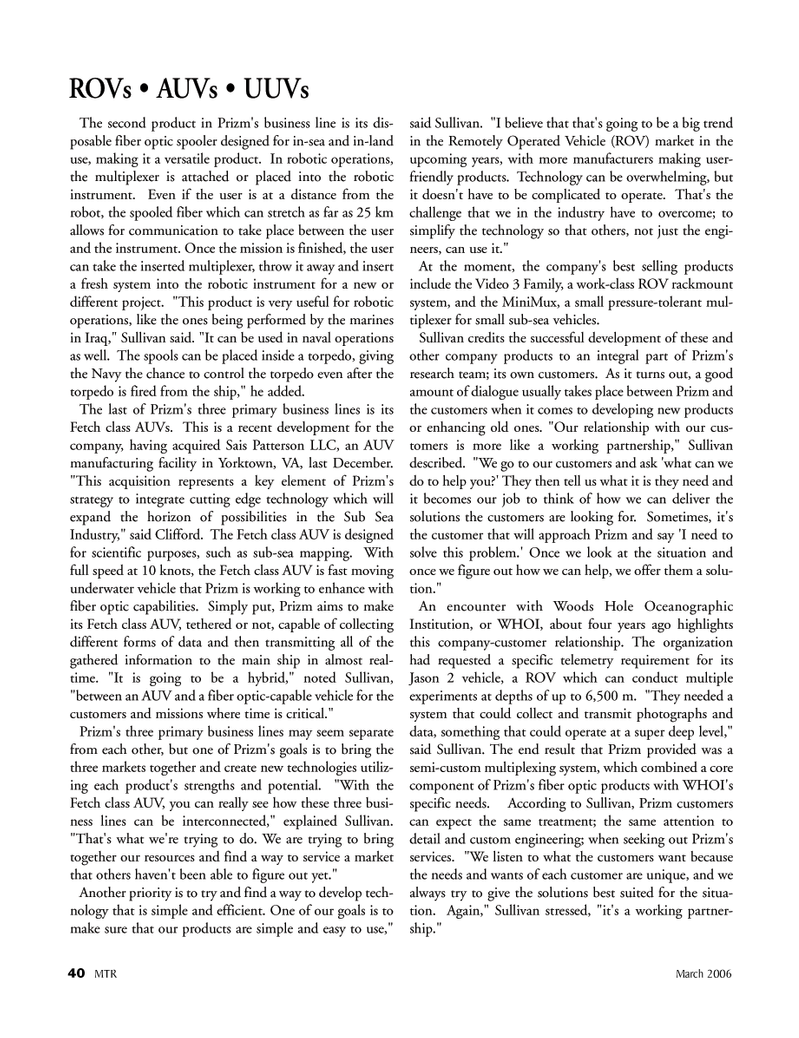
Page 39: of Marine Technology Magazine (March 2006)
AUVs; ROVs; UUVs
Read this page in Pdf, Flash or Html5 edition of March 2006 Marine Technology Magazine
40 MTR March 2006
The second product in Prizm's business line is its dis- posable fiber optic spooler designed for in-sea and in-land use, making it a versatile product. In robotic operations, the multiplexer is attached or placed into the robotic instrument. Even if the user is at a distance from the robot, the spooled fiber which can stretch as far as 25 km allows for communication to take place between the user and the instrument. Once the mission is finished, the user can take the inserted multiplexer, throw it away and insert a fresh system into the robotic instrument for a new or different project. "This product is very useful for robotic operations, like the ones being performed by the marines in Iraq," Sullivan said. "It can be used in naval operations as well. The spools can be placed inside a torpedo, giving the Navy the chance to control the torpedo even after the torpedo is fired from the ship," he added.
The last of Prizm's three primary business lines is its
Fetch class AUVs. This is a recent development for the company, having acquired Sais Patterson LLC, an AUV manufacturing facility in Yorktown, VA, last December. "This acquisition represents a key element of Prizm's strategy to integrate cutting edge technology which will expand the horizon of possibilities in the Sub Sea
Industry," said Clifford. The Fetch class AUV is designed for scientific purposes, such as sub-sea mapping. With full speed at 10 knots, the Fetch class AUV is fast moving underwater vehicle that Prizm is working to enhance with fiber optic capabilities. Simply put, Prizm aims to make its Fetch class AUV, tethered or not, capable of collecting different forms of data and then transmitting all of the gathered information to the main ship in almost real- time. "It is going to be a hybrid," noted Sullivan, "between an AUV and a fiber optic-capable vehicle for the customers and missions where time is critical."
Prizm's three primary business lines may seem separate from each other, but one of Prizm's goals is to bring the three markets together and create new technologies utiliz- ing each product's strengths and potential. "With the
Fetch class AUV, you can really see how these three busi- ness lines can be interconnected," explained Sullivan. "That's what we're trying to do. We are trying to bring together our resources and find a way to service a market that others haven't been able to figure out yet."
Another priority is to try and find a way to develop tech- nology that is simple and efficient. One of our goals is to make sure that our products are simple and easy to use," said Sullivan. "I believe that that's going to be a big trend in the Remotely Operated Vehicle (ROV) market in the upcoming years, with more manufacturers making user- friendly products. Technology can be overwhelming, but it doesn't have to be complicated to operate. That's the challenge that we in the industry have to overcome; to simplify the technology so that others, not just the engi- neers, can use it."
At the moment, the company's best selling products include the Video 3 Family, a work-class ROV rackmount system, and the MiniMux, a small pressure-tolerant mul- tiplexer for small sub-sea vehicles.
Sullivan credits the successful development of these and other company products to an integral part of Prizm's research team; its own customers. As it turns out, a good amount of dialogue usually takes place between Prizm and the customers when it comes to developing new products or enhancing old ones. "Our relationship with our cus- tomers is more like a working partnership," Sullivan described. "We go to our customers and ask 'what can we do to help you?' They then tell us what it is they need and it becomes our job to think of how we can deliver the solutions the customers are looking for. Sometimes, it's the customer that will approach Prizm and say 'I need to solve this problem.' Once we look at the situation and once we figure out how we can help, we offer them a solu- tion."
An encounter with Woods Hole Oceanographic
Institution, or WHOI, about four years ago highlights this company-customer relationship. The organization had requested a specific telemetry requirement for its
Jason 2 vehicle, a ROV which can conduct multiple experiments at depths of up to 6,500 m. "They needed a system that could collect and transmit photographs and data, something that could operate at a super deep level," said Sullivan. The end result that Prizm provided was a semi-custom multiplexing system, which combined a core component of Prizm's fiber optic products with WHOI's specific needs. According to Sullivan, Prizm customers can expect the same treatment; the same attention to detail and custom engineering; when seeking out Prizm's services. "We listen to what the customers want because the needs and wants of each customer are unique, and we always try to give the solutions best suited for the situa- tion. Again," Sullivan stressed, "it's a working partner- ship."
ROVs • AUVs UUVs
MTR#2 (33-48).qxd 2/23/2006 4:37 PM Page 40

 38
38

 40
40
